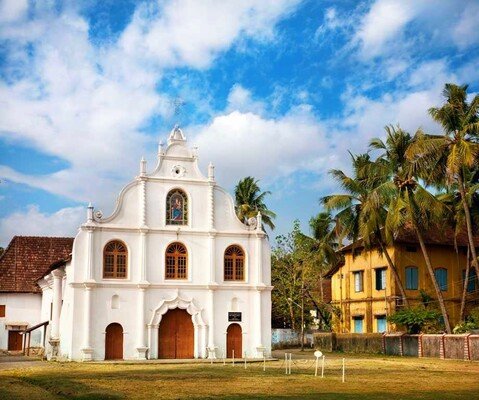It is a mix of contemporary and ancient tourist attractions, with both the past and future legs. There’s no other spot in India to share with a 400-year-old synagogue, antique mosques, Portuguese homes and Raj’s collapsing settings. No other locations but these are in India. The most visitors to Ernakulam, however, are attracted by Keralan art shows. Here some of the pilgrims in Ernakulam.
Paradesi Synagogue

Paradesi Synagogue is India’s oldest synagogue, located in Kochi (formerly Cochin) in Kerala. It was one of the Cochin (or Kerala) Jews’ traditional places of worship. It was the community’s only operating synagogue in India in the early twenty-first century. The Jewish synagogue was constructed in 1568, about 1500 years after the Jewish connection to Kerala began. It was erected on land donated by the erstwhile monarch of Cochin, near to the Mattancherry Palace. In various Indian languages, the word Paradesi denotes “foreigner.” It refers to the White Jews, who are a combination of Kodungalloor, Middle Eastern, and European Jews.
Vallarpadam Church

The Vallarpadam Church, also known as the Basilica of Our Lady of Ransom, is an old church in the Ernakulam region of Kerala that is located in the heart of Vallarpadam. The church is dedicated to the Blessed Mary of Vallarpadam, also known as ‘Vallarapadath Amma.’ Though it was devastated by a major flood in 1676, it was repaired the next year. Then, in 1888, Pope Leo XIII declared it a special church, and the Union Government named it a prominent pilgrimage destination. The greatest time to go is during Vallarapadath Amma’s feast, which takes place on September 24 and lasts for a week.
Chottanikkara Bhagavathy Temple

Chottanikkara Bhagavathy Temple is a famous temple in Kochi’s outskirts that dates back to the 10th century CE. This is one of Kerala’s most prominent pilgrimage destinations. The deity is said to have the ability to heal mental illnesses. Rajarajeswari (Mother Goddess) is worshipped in three forms here: Goddess Saraswathy in the morning, Goddess Lakshmi in the noon, and Goddess Durga in the evening. The Makam Thozhal is one of Chottanikkara temple’s most prominent festivities. It is seen in the Malayalam month of Kumbham (mid-February to mid-March) on the Makam asterism.
Ernakulam Shiva Temple

This edifice, also known as Ernakulathappan (Lord of Ernakulam) Temple, exemplifies the splendour of ancient Kerala architecture. Lord Shiva is the principal deity here. The temple is located in the centre of Ernakulam Town in Kerala, near Kochi. The sanctum sanctorum’s walls are adorned with magnificent sculptures, while the ceiling decorations are constructed of copper tiles. The temple is located in the Durbar Hall Ground and was built during the Maharaja era. The shrine’s history is intertwined with that of the city. According to history, it was once one of Kochi Maharajas’ seven royal temples, but it is now administered by the Cochin Devasom Board.
Vamanamoorthy temple

The Vamanamoorthy temple in Thrikkakara, near Ernakulam, has inscriptions dating from the 10th to the 13th centuries. This is the solitary temple devoted to Vamana, one of Lord Vishnu’s incarnations, who terminated King Mahabali’s great reign as a Brahmin kid. Lord Vamana, Lord Vishnu’s fifth incarnation, is the temple’s principal deity. Thrikkakara Temple, in the Ernakulam region, draws devotees because of its fabled connection to Kerala’s harvest festival, Onam. The sanctum sanctorum of the temple is known for its magnificent engravings on the walls. These paintings represent Onam celebrations that date back over 2500 years.
Santa Cruz Basilica

This church, one of India’s eight basilicas, was built by the Portuguese Santa Cruz Basilica in Kochi. This Kerala historic building, which is also one of the best cathedrals in India and serves as the cathedral church of the Diocese of Cochin, is located near the famed St. Francis Church. It is a Roman Catholic Cathedral in Fort Kochi, located on K.B. Jacob Road. It’s a holy sanctuary and a historical landmark, brimming with aesthetic splendour and medieval-style colours. The Basilica features excellent Indo-European and Gothic architecture, as well as the use of colour to great effect. It has two gleaming spires. The monument’s enduring beauty is owed in large part to its pastel-colored interior, which is filled with works by Italian painter Brother Antonio Moscheni and his Bangalore protégé De Gama. In the Basilica’s altar, Moscheni painted stunningly exquisite paintings on the theme of “The Passion and Death on the Cross.” His recreation of Leonardo da Vinci’s “The Last Supper” is a sight to behold. The exquisite stained glass windows, as well as the frescoes and murals depicting Christ’s life that adorn the ceilings and interior, add to the place’s attractiveness. The bright blue pillars at the entryway and the pulpit also attest to the skill of those who worked on the spectacular monum.
St Francis Church

With a history dating back to the 16th century, the St. Francis Church is one of Kochi’s most notable landmarks. St. Francis Church is known for its exquisite architecture and atmosphere and is thought to be one of India’s earliest European-built churches. It’s a historical site where the late legendary explorer Vasco da Gama was laid to rest. Vasco da Gama, the first European to locate a path to India, is said to have died in this location in the year 1524. It was his third visit to this church, and he was laid to rest here. After 14 years, his remains were said to have been moved to Lisbon, yet his gravestone can still be seen in this church. Tourists come from all over the world to pay their respects to Vasco da Gama’s tombstone.
